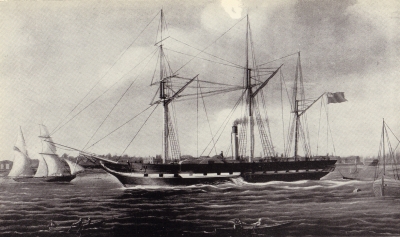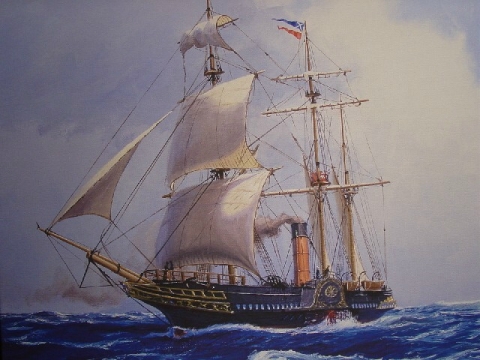

Steamships, Part 8 to the Life & Works of
Samuel Cunard

When we think of the Royal William, we think of the first transatlantic voyage of a steamship.29 A typical entry, "The Royal William sailed for London from Quebec on August 5th, 1833, and arrived at Gravesend on September 16th following a passage of over 40 days." No mention of Cunard, nor of Halifax. It was owned by a company, the Quebec and Halifax Steam Navigation Company which was set up in 1825. Three of its investors, however, were Cunard brothers. She was built at Quebec where most of the investors in the company were located. It was intended that she should make regular runs between Quebec and Halifax. Launched during April, she first arrived at Halifax, docking at Cunard's Wharf30, on August 31st, 1831. While at his wharf, Cunard boarded the Royal William; he asked questions and took notes. She had a length of 160 feet had a width of 44 feet and a draft of about 18 feet; she was a side-wheeler with two engines of eighty horsepower each; she was however a fully rigged sailing ship. She could carry 80 passengers and had a crew of 36. During the year of 1831, she made three runs which included stops at both the Miramichi (lumber) and Pictou (coal). Big problems came calling in 1832. Cholera had broken out and she spent most of her time in quarantine. Laid up for the winter, it would appear that no appropriate steps were taken so to winterize her; the consequences were that a number of bursted pipes were found in the spring. All of this placed a financial burden on the company. In 1833, the Royal William was sold at London, England, to the Spanish Navy.31
In 1838, while sailing to England, Judge Haliburton made observations which he likely passed on to his friend, Samuel Cunard, observations which confirmed in Cunard's mind that there was a great commercial future for steamships.
It might be said that the big break came for Cunard when he won over the British Postal Service. He offered to establish a reliable and regular schedule for the pickup and delivery of mail destined for North America.33 To maintain such a schedule he would need large and fast steamships. He employed Robert Napier of the Glasgow firm of Wood and Napier; Napier was reputed to be the best marine engineer in Britain. This was going to be a pricey venture and capital would have to be raised, and Cunard decided to raise capital right in the city where the ships would be built, Glasgow. Of the £270,000 raised, £55,000 came from Cunard, the largest investor by far and away. After further negotiations with the postal authorities34 and with the ship builders at Glasgow, the keels of four steamships were laid down on the docks along the Clyde: the Britannia, the Acadia, the Caledonia and the Columbia.
From his correspondence we see how Cunard was particular when it came to the building of his ships:
The Britannia was 207 feet long with a beam of 34 feet. She was a two-decker with one red funnel amidships and huge paddle wheels. She had a square stern, a clipper bow and a bronze figurehead. She was bark-rigged: fore and aft sails on the mizzenmast and squared rigged on the main and fore masts. She could carry 600 tons of coal to feed the three furnaces making steam that would drive her along at 8 1/2 knots. She carried ninety-three crew members and sixty passengers, including, on her maiden voyage: Cunard, his seventeen year old daughter, Anne, and her sixteen year old friend, Laura Haliburton (who in time married Anne's brother, William.)36
Halifax was not the terminus for the Britannia, it was Boston, though Cunard tried to convince the authorities that it should be Halifax. His idea was that he could transport the mail from England by a smaller steam vessel running from Halifax to Boston, leaving the larger Britannia to make an immediate run back to England.
The Britannia left Boston on August 3rd, 1840. She arrived at Halifax next day. She stayed at Halifax only as long as it took: to take off the mail bags, for the disembarkment of passengers, refuel, embark passengers, and to take aboard the mail bags. Then it was off to England, so to meet Cunard's contractual obligation to arrive at a scheduled time. At this time, Cunard's smaller steamship, the Unicorn, was employed in running the mail and passengers from Halifax to Quebec.
By the end of January, 1841, all four of Cunard's transatlantic steamers were in service, service to and from Europe, Boston and Halifax. There were competitors but fortune did not smile down on them as it did on Cunard. One competitor had but two steamships and one was lost at sea and could not recover from the loss. Another had its finances dry up. Not that Cunard did not have his reverses. After having the advantage a securing his business for three years running, Cunard, in 1843, experienced the loss of one of his steamers: the Columbia. She went aground on a ledge (Devil's Limb) near Seal Island on the southwestern point of peninsular Nova Scotia. The ship carried 85 passengers and 73 crew; there was no loss of life but the ship was wrecked. Vessels were sent down from Halifax by Cunard himself and the cargo of the Columbia -- timber, machinery and other goods, and, of course the mail bags -- were brought up to Halifax.37 The loss of the Columbia did not help those who promoted Halifax to be the principal port for the British mail. "One of the New York papers, the Herald -- the port of New York was also looking for business -- observed that maybe international steamers should avoid Nova Scotia, it being "450 miles of rock, ledge, shoals and fog."
"Already he had witnessed one proof of the power of steam. In 1838, in company with Haliburton, he was on his way to England on the Tyrian, one of the old ten-gun brigs which carried the mails, slow and uncomfortable at the best, unseaworthy death-traps in a storm. As she lay rolling in a flat calm with flapping sails, a few hundred miles from England, a smear appeared on the western horizon. The smear grew to a smudge, the smudge to the Sirius, a steamer which had successfully crossed the Atlantic, and was now on her return to England. The captain of the Tyrian determined to send his mails on board. Howe accompanied them, took a glass of champagne with the officers, and returned to the brig. Then the Sirius steamed off, leaving the Tyrian to whistle for a breeze. On their arrival in England, Howe and Haliburton succeeded in combining the chief British North American interests in a letter to the Colonial Office. That much-abused department showed sympathy and promptitude. Negotiations were entered into, contracts were let, and in 1840 the mails were carried from England to Halifax by the steamers of a company headed by Samuel Cunard, a prominent Halifax merchant, founder of the line which still bears his name. At once the distance from England to Nova Scotia was reduced from fifty days to twelve. Certainty replaced uncertainty; danger gave way to comparative security. It was the forging of a real link of Empire."32
The very first steamship owned by the Cunard Line was the Unicorn. She was a three masted schooner built of wood at Greenock, Scotland. Powered by "two side lever engines," she had a length of 163 feet. Her boilers were supplied by fresh water thus eliminating the "salting up of the boiler" problem which plagued the earlier steamships such as the Royal William. ("Salting up" required regular cleaning of the boilers, even when underway.)
"I shall want these vessels to be of the very best description, and to pass a thorough inspection and examination of the Admiralty. I want a plain and comfortable boat, not the least unnecessary expense for show. I prefer plain work in the cabin, and it will save a large amount in the cost."35
The Britannia, the first of the Cunard steamers ready to go, was launched at Glasgow on February 5th, 1840. Her maiden voyage was between Liverpool and Halifax. She left on July 4th and arrived on July 17th. Up to this time, mail for the colonies was put on a packet which sailed from Falmouth (the "Falmouth Packet"). Liverpool was an up and rising shipping centre, and, being located on the western side of England, cut time away from the transatlantic passage.
"When the new Cunard schedule started in 1848, Halifax had the best overseas communication in America with two steamers a week, one coming and one going alternately to Boston and New York. In addition, Cunard had extended the Halifax-Bermuda packet service to the West Indies and had replaced the sailing packets with steamers. They ran once a month, bringing passengers bound for Europe up from the islands and from South America to connect with the Atlantic steamers."38
Before passing on, a few words about the Cunard Line: it continued as a private company owned by the Cunard family and others. It went public in 1880. In the succeeding years some very famous liners were launched by Cunard, including: Campania (1893), Lucania (1893), Lusitania (1907), Mauretania (1907) and Queen Mary (1934). In 1934, the Cunard Line amalgamated with its old rival, the White Star Line to become Cunard-White Star. By then no Cunard family member was active in the running of the company, indeed, not since 1922.
Or, GO TO
TABLE OF CONTENTS.
_______________________________[Up]
Peter Landry
2012 (2020)